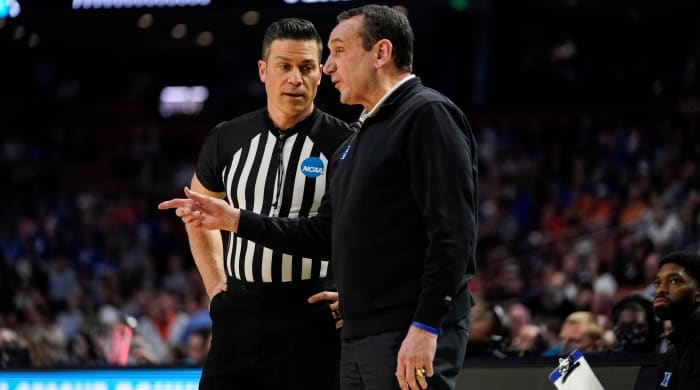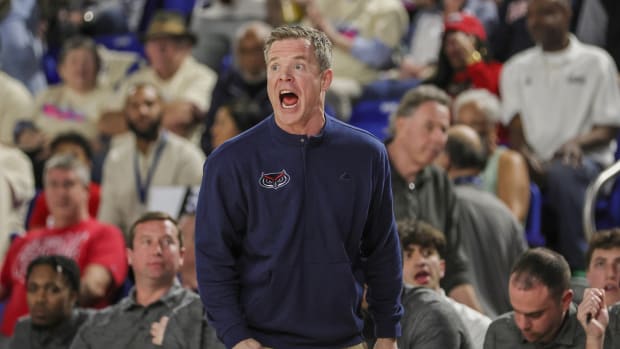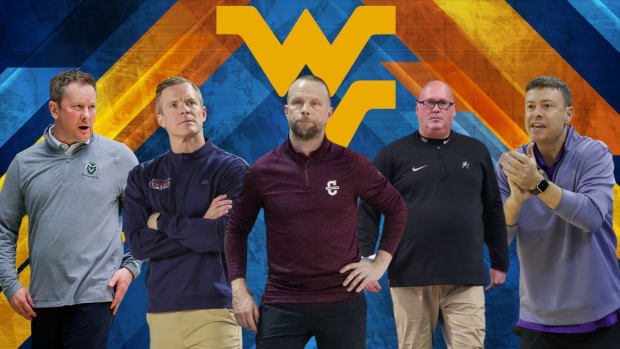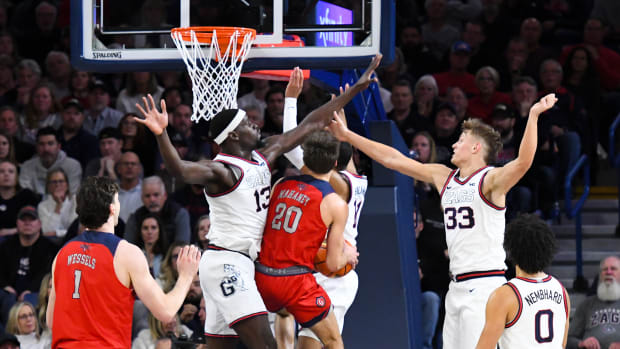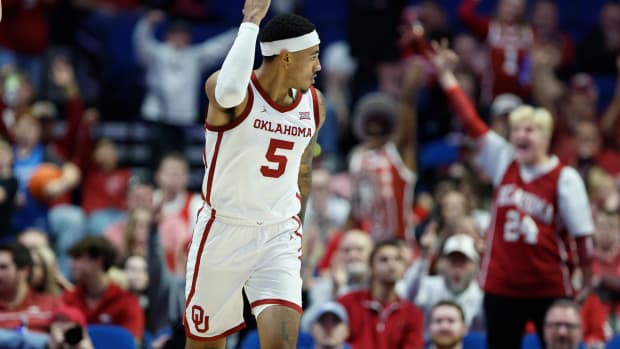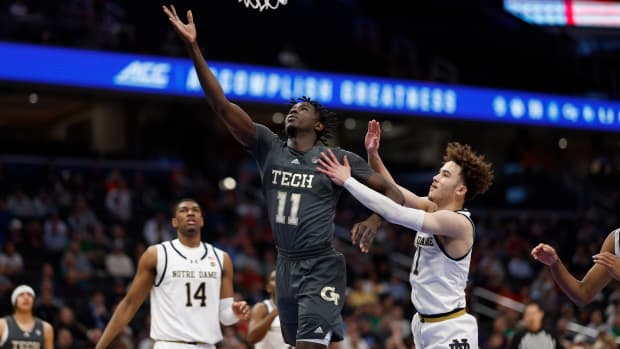NCAA Tournament Showcasing Lack of Consistency and Accountability in Officiating
When North Carolina’s Brady Manek fired an elbow into the face of Baylor’s Jeremy Sochan with 10:08 left in an NCAA Tournament second-round game Sunday, it sent the officiating crew working the game to the replay monitor with a big decision to make. Eject a key player from an elimination game, or assign a lesser penalty and play on?
Ultimately, the crew of Donnie Eppley, Kipp Kissinger and Brent Hampton made the right call: It was a flagrant 2 foul and Manek had to go. The strange part is everything that happened thereafter.
The game dissolved into a street fight, with Baylor implementing an extremely physical full-court press that reduced a 25-point deficit to a manageable number in shockingly rapid time. Rather than rein in the contact, the refs became bystanders. The Bears bumped and shoved and slapped, and the whistles did not blow—well, at least not against the aggressor that was playing desperately to get back into the game. The whistles blew many times against North Carolina.
Aside from a double foul assessed to both teams, the next seven calls were all fouls on the Tar Heels. That’s not to mention the no-calls that went against Carolina while being waylaid. The most egregious: guard Caleb Love being body-blocked at midcourt, with the result being a turnover and Baylor dunk. There also was a blatantly missed out-of-bounds call late in the game that was ruled Baylor ball and had to be overturned on review.
The reigning national champion Bears got the game into overtime, a mind-boggling comeback in 10 minutes of game time, but they had help. North Carolina regrouped and won in OT, which spared the officials even more criticism than what was being heaped upon them via social media as the hackfest unfolded.
“No reasonable person could suggest that game was called correctly,” said ESPN analyst Jay Bilas, a member of the NCAA men’s basketball competition committee and an unstinting on-air critic of the current state of college hoops officiating.
Now here’s the kicker: Two of the three officials in that fiasco reportedly will work in the Sweet Sixteen. According to Stadium’s Jeff Goodman, Hampton is one of nine assigned to work the East Regional this week and Kissinger will work the South. They somehow graded highly enough to advance.
Bad officiating was rewarded. And not just in that game. After two rounds of nationwide outcry over the refereeing of the tournament, the NCAA says everything is fine and acknowledges no extraordinary issues.
“The officials have done a nice job thus far in the tournament,” national coordinator of officials J.D. Collins told Sports Illustrated this week. "Over the last three seasons we average 96% call accuracy when we blow our whistle and (about) 90% when we add plays where we should have blown the whistle. This year’s officials are at that standard again this year.”
Bilas’s response to that 96% grade: “J.D. Collins is a nice guy, but who are we trying to kid here? Whoever created that grade, I want to take their class. That’s an easy A.”
As noted above, there were issues beyond North Carolina-Baylor that haven’t sidelined several of the involved officials. While Brian O’Connell rightfully did not advance to work the Sweet 16 after calling a mystifying technical foul on Illinois’s R.J. Melendez for hanging on the rim, others involved in controversy did advance.
In Notre Dame’s narrow loss to Texas Tech, Red Raiders forward Kevin McCuller had a breakaway dunk. For some reason he reached up and grabbed the rim with his off hand before flushing the ball—a clear basket interference call that went unmade. Replays showed veteran official John Higgins looking directly at the play and still not making the call. That game became extremely physical in the final minutes as well, which benefitted the Red Raiders.
“John Higgins, he’s got to be going in the Big 12 Hall of Fame this summer, right?” Said one prominent college coach who watched the Notre Dame-Texas Tech game, noting that Higgins has long called Big 12 games and the Red Raiders are members of that conference. “Why would he be allowed to call that game?”
Higgins has advanced to work the East Region, according to Goodman. Paul Szelc, who also had the Notre Dame-Texas Tech game, will work the South Region this week.
The final game of the second round saw TCU trying to shock No. 1 seed Arizona on the last possession of regulation. Guard Mike Miles dribbled himself into trouble near midcourt in the final seconds and ultimately was trapped, bumped and turned the ball over. There was no call of an obvious foul—but there also was no over-and-back call on MIles, who stepped on the midcourt line just before being body-blocked.
The officials, at least one of whom appeared to be badly out of position, called nothing. Crew members Keith Kimble and Doug Shows will work the Midwest and West regions this week, according to Goodman.
“The call in the Arizona-TCU game, they missed one,” Bilas said. “It’s the calls in the course of the game that weren’t made that are the problem. But the veteran officials know that someone has to advance. They need someone to call the games.”
Indeed, the officiating talent pool is shallow enough that the big-name refs are virtually assured of advancing in the tournament regardless of how they actually perform. Ken Pomeroy’s website tracks all Division I officiating assignments and ranks the refs according to the level of regular-season games they are assigned, per his metrics. His reasoning is sound: The officials most highly regarded by the conferences get the biggest games.
This year, 17 of Pomeroy’s top 18 refs are still in the tourney. That includes Kimble (No. 1), Higgins (No. 5), Kissinger (No. 7), Shows (No. 8) and Szelc (No. 13), despite being involved in controversial games. Did they get there on past reputation, or current performance? “It’s sort of an old boys’ network,” one coach said.
Administrators from the tournament teams, members of the Division I men’s basketball committee and officiating monitors all provide input on the referees after every tourney game. They are given three options for rating an official: “strongly recommend” to advance; “recommend” to advance; and “do not recommend” to advance. Some wonder how much their feedback is considered.
“Why even ask for our input if they’re just going to advance who they want?” Asked one administrator who gave a “do not recommend” vote over the weekend on an official who advanced.
Collins said he’s only heard from one complaining coach in 52 tournament games thus far. But in the wider world, people are talking as much about the officiating as they are about Cinderella Saint Peter’s and Mike Krzyzewski’s quest to go out on top.
“This is the first time in a while that the officiating is a story,” said one prominent athletic director. “That’s disappointing.”
The disappointment is threefold:
- Officiating is difficult, and has become a thankless task. It’s hard to cultivate the next generation of refs when the current generation is steeped in criticism.
- The magnificence of this tournament is undercut by sore-loser conspiracy theorists who would rather declare their team cheated by the refs than fairly beaten. This mirrors the current political climate, when losers readily label elections stolen instead of lost.
- Public doubt in the officials is problematic for the NCAA to confront and publicly acknowledge during the showcase of March Madness. That undoubtedly fuels some of the NCAA’s “Everything Is Fine” rhetoric.
“I understand why people in a position of authority are loath to undermine confidence in the officials,” Bilas said. “We don’t need to do that. But we also doin’t need to make excuses and rationalizations. We need to be accountable.”
The primary problem as Bilas sees it—and I agree—is that the attempt to restore freedom of movement a few years ago has not only stalled, it’s gone in reverse. The college game has returned to hammer-and-tong defense beating up pass-and-cut offense. Artistry is losing to brute force.
“The way these games are being officiated and called and how college basketball has kind of morphed into this … it’s pretty rugby-like in a lot of instances,” Gonzaga’s Mark Few said Wednesday.
This can be exacerbated in the tournament, when officials are even more reticent to foul out star players or make a call that decides a season-ending game for the losing team. The smarter approach for a ref trying to advance is probably a no-call over a controversial call. Letting the players decide it on the floor is a nice sentiment, but not calling fouls can decide a game, too.
The defining stat on this issue: the 16.65 fouls called per team per game is the lowest in Division I history, or at least dating to 1948, the first year for which the NCAA has national statistics. If that holds through the rest of the tourney, it will be the third straight year of an all-time low in fouls called.
Corresponding numbers: Scoring is down to 71.06 points per game, lowest it has been since 2015. Field goal percentage is 44.08%, down from last year and the second-lowest it has been in the last six years.
“They’re not calling the clear fouls,” Bilas said. “It’s pretty simple. There was really great progress, and we’ve seen it all go away this year.”
Rarely has that been more clear than in the North Carolina-Baylor demolition derby Sunday. But in a sport strapped for quality officials, even presiding over that fiasco isn’t enough to get the whole crew sent home for the rest of the tournament.
More College Basketball Coverage:
• Ranking the 2022 Women’s Sweet 16
• SEC Men’s Basketball Hits a Hard Reset With Slew of New Coaching Hires
• Miami’s Isaiah Wong Focused on Seizing the Moments in March
• The Madness of March Has Led to a Truly Diverse—and Unpredictable—Men’s Sweet 16
